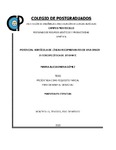| dc.description.abstract | El jitomate (Solanum lycopersicum L.) es una de las princi¬pales hortalizas cultivadas a nivel mundial, siendo los diez principales países produc¬tores China, India, Estados Unidos, Turquía, Egipto, Irán, Italia, España, Brasil y México. Las semillas de jitomate que permiten estos niveles de producción en México, han sido mejoradas por empresas transnacionales cuyos programas de mejoramiento genético hacen uso de los recursos genéticos de la especie y de sus parientes silvestres, ya que varios investigadores han mencionado que el jitomate cultivado presenta una reducida variación genética, la cual es el resultado de varios cuellos de botella genéticos que ha sufrido a través del tiempo, además del proceso de domesticación mismo y de su sistema de reproducción por autogamia. Ante tal situación el uso de germoplasma nativo mexicano “criollo” domesticado o en proceso de domesticación, así como de parientes silvestres del jitomate cultivado ha sido una opción que los mejoradores han explotado para buscar variantes alélicas de calidad y de resistencia a factores bióticos y abióticos. Con los objetivos de ampliar la base genética del jitomate cultivado, generar germoplasma base para el mejoramiento genético en México y evaluar el potencial hortícola de líneas recombinantes S3 derivadas de una cruza interespecífica, un grupo de 225 líneas fueron evaluadas bajo invernadero y en condiciones de hidroponía. Los materiales genéticos fueron líneas S3 derivadas de una cruza interespecífica entre S. lycopersicum y S. pinpinellifolium obtenidas por el método de “semilla por descendencia única”. La cruza interespecífica entre la especie silvestre S. pimpinellifolium y el jitomate cultivado (LOR-82) permitió la creación de líneas recombinantes con diversas combinaciones alélicas del genoma del jitomate cultivado y esta especie silvestre, que resultaron en una gran variación en cuanto a las variables evaluadas, que básicamente fueron rendimiento y sus componentes, así como algunas variables de calidad, como grados °brix, donde hubo líneas con valores de hasta 10% en sólidos solubles totales. Las líneas generadas representan una importante fuente de germoplasma que puede ser usado en programas de mejoramiento genético de jitomate en México. Algunas de ellas incluso podrían usarse de manera directa como variedades de polinización libre. Las diferencias en tamaño, forma y grados °brix de las líneas aquí derivadas permitiría que los mejoradores seleccionen aquéllas que reúnen las características deseables para sus programas de mejoramiento, pues en cuanto a tamaño las hubo desde un peso promedio de 1 g hasta 36 g y de 3.4 a 10.2 °brix, así como de rendimientos que variaron desde 16 a 1330 g por planta y un número de frutos por racimo de 8 a 115. Las variables que mejor explicaron el rendimiento (peso de fruto por planta) de manera significativa fueron el peso promedio de fruto, longitud y diámetro de fruto, así como el número total de frutos por planta. Las heredabilidades en sentido amplio para componentes del rendimiento tuvieron valores relativamente altos, mayores de 0.60, mientras que para grados °brix fue de 0.50. _______________ HORTICULTURAL POTENTIAL OF RECOMBINANT LINES DERIVED FROM A TOMATO INTERSPECIFIC CROSS. ABSTRACT: Tomato (Solanum lycopersicum L.) is one of the major vegetables grown around the world, being China, India, United States, Turkey, Egypt, Iran, Italy, Spain, Brazil and Mexico the top ten producing countries. The tomato seeds that allow getting these high levels of production in Mexico have been generated by transnational private companies, whose plant breeding programs take advantage and make use of the genetic resources of the species and their wild relatives, as several researchers have mentioned that the cultivated tomato presents a reduced genetic variation, which is the result of several genetic bottlenecks that it has suffered through time, in addition to the domestication process effect and its system of reproduction by autogamy. Before this situation, the use of Mexican native tomato germplasm "landraces" domesticated or in process of domestication, as well as tomato wild relatives, has been an option that plant breeders have exploited to search for allelic variants of quality and resistance to biotic and abiotic factors. With the objectives of increasing the genetic background of cultivated tomato, generating basic germplasm for breeding in Mexico, and assessing the horticultural potential of recombinant S3 lines derived from an interspecific cross, a group of 225 lines were evaluated under greenhouse and hydroponics conditions. Genetic materials were S3 lines derived from an interspecific cross between Solanum lycopersicum and S. pinpinellifolium obtained by the method of single seed descent. The interspecific cross between the cultivated tomato (LOR-82) and the wild species S. pinpinellifolium allowed the creation of recombinant lines carrying different allelic combinations from the cultivated tomato genome and this wild species, which resulted in a wide variation in terms of the traits evaluated, which basically were fruit yield and its components, as well as some important traits, such as Brix degrees, where there were lines with values up to 10% on total soluble solids. The generated lines represent an important source of germplasm that can be used in tomato breeding programs in Mexico. Some of them even could be used directly as open-pollinated varieties. The differences in size, shape, and Brix degrees of the lines derived here would allow breeders to select those ones that meet the characteristics desirable for their breeding programs, as in terms of fruit size, the values for weight ranged from 1 g to 36 g and for °brix from 3.4 to 10.2. In the same way, fruit yields ranged from 16 to 1330 g per plant and from 8 to 115 for number of fruits per cluster. The traits that best explained yield (fruit weight per plant) in a significant way were average fruit weight, fruit length and diameter, as well as the total fruit number per plant. The broad sense heritability for yield components had values relatively high, greater than 0.60, while for Brix degrees it was 0.50. | es_MX |


